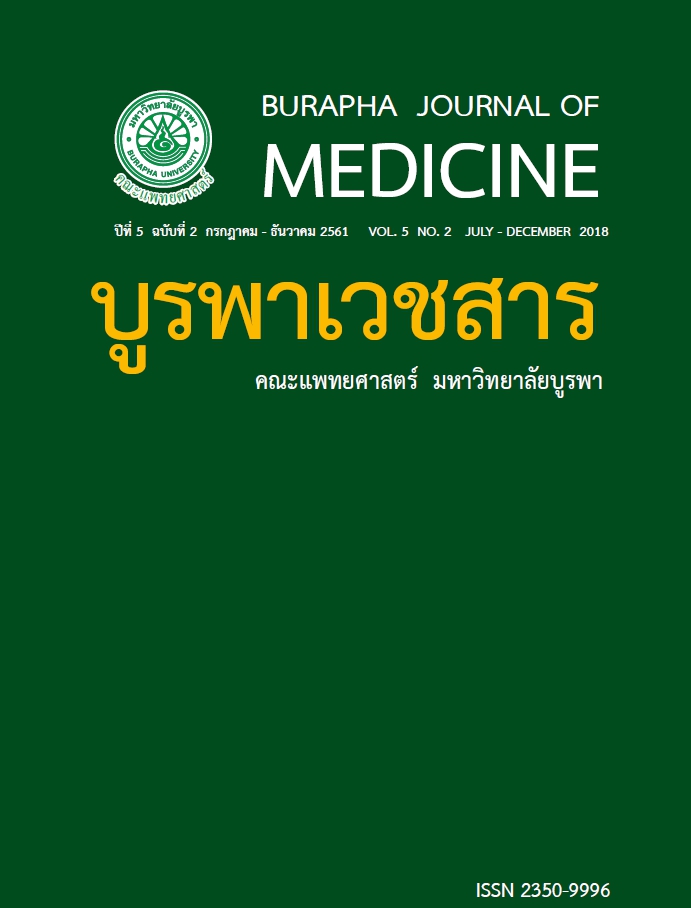การลดอาการเกร็งของกล้ามเนื้อในผู้ใหญ่ที่เป็น โรคหลอดเลือดสมอง
คำสำคัญ:
อาการเกร็งของกล้ามเนื้อ, โรคหลอดเลือดสมอง, การฟื้นฟูสมรรถภาพบทคัดย่อ
Spasticity is a condition commonly found in stroke patients. This condition limits these
patients from carrying out their daily activities. Rehabilitation that aims to reduce spasticity is
a significant factor for the effectiveness of treatment. It can help patients to restore muscular
functions, making them much more independent. The severity of the patient’s spasticity, and
the degree to which day to day activities become an obstacle, indicates the management
needed for this condition. Therefore, physical treatment with a multidisciplinary approach
should be considered as the first priority. If significant spasticity persists, medical treatment (or
an additional technique) should be considered according to the type of spasticity as well as
the seriousness of the patient’s limitations. The physician should carefully assess a suitable
treatment method giving the most benefit to the patient. This article is designed to review the
variety of treatment methods for reducing spasticity in adults with stroke.
เอกสารอ้างอิง
ประชากรผู้สูงอายุในประเทศไทย พ.ศ. 2550.
กลุ่มสถิติ 4ส?ำนักสถิติเศรษฐกิจสังคมและ
ประชามติ. [อินเทอร์เนท]. เข้าถึงเมื่อ: 26
กันยายน 2561. เข้าถึงได้จาก:http://service.
nso.go.th/nso/nsopublish/service/survey/
rep_older50.pdf
2. กองยุทธศาสตร์และแผนงาน ส?ำนักงานปลัด
กระทรวงสาธารณสุข. สรุปสถิติที่ส?ำคัญ พ.ศ. 2560.
[อินเทอร์เนท]. เข้าถึงเมื่อ: 26 กันยายน 2561. เข้าถึง
ได้จาก: http://bps.moph.go.th/new_bps/
sites/default/files/health%20stratistic%20
2560.pdf
3. ส?ำนักโรคไม่ติดต่อ กรมควบคุมโรค กระทรวง
สาธารณสุข. รายงานประจ?ำปี 2560 [อินเทอร์เนท].
เข้าถึงเมื่อ: 26 กันยายน 2561. เข้าถึงได้จาก:
http://www.thaincd.com/document/file/
download/paper-manual/NCDReport60.pdf
4. กลุ่มพัฒนาระบบสาธารณสุข ส?ำนักโรคไม่ติดต่อ
กรมควบคุมโรค. ประเด็นสารรณรงค์วันอัมพาตโลก
ปี 2560 [อินเทอร์เนท]. เข้าถึงเมื่อ: 26 กันยายน
2561. เข้าถึงได้จาก: http://www.thaincd.com/
document/file/info/non-communicabledisease/
2560_.pdf
5. กิ่งแก้ว ปาจรีย์, บรรณาธิการ. การฟื้นฟูสมรรถภาพ
ผู้ป่วยโรคหลอดเลือดสมอง. พิมพ์ครั้งที่ 1. กรุงเทพฯ
งานตำ? ราวารสารและสิ่งพมิ พ ์ สถานเทคโนโลยีการ
ศึกษาแพทยศาสตร์ คณะแพทยศาสตร์ศิริราช
พยาบาล; 2547.
6. อารีย์รัตน์ สุพุทธิธาดา. ภาวะกล้ามเนื้อหดเกร็ง.
พิมพ์ครั้งที่ 1. กรุงเทพฯ: คณะแพทยศาสตร์
จุฬาลงกรณ์มหาวิทยาลัย; 2547.
7. Akpinar P, Atici A, Ozkan FU, et al. Reliability
of the Modified Ashworth Scale and
Modified Tardieu Scale in patients with
spinal cord injuries. Spinal Cord. 2017; 55:
944–9.
8. Bohannon RW. Smith MB. Interrater
reliability of a Modified Ashworth scale
of musclespasticity. Phys Ther. 1987; 67:
206-7.
9. Randall L. Braddom, editor. Physical
Medicine & Rehabilitation. 3rd edition. China:
Elsevier Inc; 2007.
10. Thompson AJ, Jarrett L, Lockley L, Marsden
J, Stevenson VL. Clinical management of
spasticity. [Internet]. Accessed: Jan 23, 2016.
Available from: http://jnnp.bmj.com.
11. Elie P. Elovic, Michal E. Eisenberg, Neil N.
Jasey, Jr. Spasticity and muscle overactivity
as components of the upper motor neuron
syndrome. In: Walter R. Frontera. Editorin-
Chief. DeLisa’s physical medicine and
rehabilitation: Principles and practice, 5th
edition. USA: LIPPINCOTT WILLIUMS &
WILKINS; 2010.
12. Cheung J, Rancourt A, Di Poce S, Levine A,
Hoang J, Ismail F, et al. Patient-identified
factors that influence spasticity in people
with stroke and multiple sclerosis receiving
botulinum toxin injection treatments.
Physiother Can. 2015; 67: 157-66.
13. Shin DS, Song R, Shin EK, Seo SJ, Park JE,
Han SY, et al. Effects of passive upper
arm exercise on range of motion, muscle
strength, and muscle spasticity in hemiplegic
patients with cerebral vascular disease.
J Korean Acad Nurs. 2012; 42: 783-90.
14. จักรกริช กล้าผจญ. การออกก?ำลังกายเพื่อการ
บ?ำบัดรักษา. ใน : เวชศาสตร์ฟื้นฟูส?ำหรับเวช
ปฏิบัติทั่วไป.พิมพ์ครั้งที่ 1. เชียงใหม่: สุทินการ
พิมพ์; 2549.
15. Ghai A, Garg N, Hooda S, Gupta T. Spasticity –
Pathogenesis, prevention and treatment
strategies. Saudi J Anaesth. 2013; 7: 453-60.
16. Bovend’Eerdt TJ, Newman M, Barker K,
Dawes H, Minelli C, Wade DT. The effects
of stretching in spasticity: A systematic
review. Arch Phys Med Rehabil. 2008; 89:
1395-1406.
17. Engineering in Medicine and Biology Society.
Effects of prolonged muscle stretch on
spasticity by an assessment/treatment
system. 2001 Proceedings of the 23rd
Annual EMBS International conference; Oct
25-28, 2001; Istanbul, Turkey: n.p.; 2001.
18. Ali A Bani-Ahmad. The evidence for
prolonged muscle stretching in ankle joint
19. management in upper motor neuron
lesions: considerations for rehabilitation. J
Nov Physiother. 2016; 6: 1-7.
20. Henricson AS, Fredriksson K, Persson I,
Pereira R, Rostedt Y, Westlin NE. The effect
of heat and stretching on the range of hip
motion. JOSPT. 1984; 6: 110-115.
21. Gehan M. Abd El-Maksoud, Moussa A.
Sharaf, Soheir S. Rezk-Allah. Efficacy of cold
therapy on spasticity and hand function
in children with cerebral palsy. Journal of
Advanced Research. 2011; 2: 319-325.
22. Elie Elovic, Ross Bogey. Spasticity and
Movement Disorder. in : Delisa JA, editor.
Physical medicine and rehabilitation :
Principles and Practice, 4th edition. USA:
LIPPINCOTT WILLIUMS & WILKINS; 2005.
23. Gerard E. Francisco. Sheng Li. Spasticity. In:
David X. Cifu, editor. Braddom’s Physical
Medicine & Rehabilitation, 5th edition.
Canada: Elsevier Inc; 2016.
24. Khunphasee A. Management of spasticity
by intramuscular neurolysis with phenol
solution. J Thai Rehabil. 1996; 6: 7-12.
25. Anannontsak A. The Use of Botulinum Toxin
Type A in the Treatment of spasticity. J Thai
Rehabil. 1996; 6: 6-17.
26. Gerbert J. Renzenbrink, Jaap H. Buurke,
Anand V. Nene, et al. Improving
walking capacity by surgical correction
of equinovarus foot deformity in adult
patients with stroke or traumatic brain
injury: A systematic review. J Rehabil Med.
2012; 44: 614-23.
27. Deltombe T, Decloedt P, Jamart J, Costa
D, Leboul P, Gustin T. Split Anterior Tibialis
tendon transfer (splatt) and achilles tendon
lengthening for the correction of the varus
foot after stroke a prospective longitudinal
study. Int J Phys Med Rehabil. 2014. S5: 006.
28. Sitthinamsuwan B, Chanvanitkulchai K,
Phonwijit L, Nunta-aree S. Kumthornthip
W. Ploypetch T. Surgical outcomes of
microsurgical selective peripheral
neurotomy for intractable limb spasticity.
Stereotact Funct Neurosurg. 2013; 91: 248-
257.
29. Deltombe T, Bleyenheuft C, Gustin T.
Comparison between tibial nerve block
with anaesthetics and neurotomy in
hemiplegic adults with spastic equinovarus
foot. Ann Phys Rehabil Med. 2015; 58: 54-9.
30. Ashford S, Turner-Stokes L. Spasticity in
adults: management using botulinum toxin.
National guidelines. London: RCP, 2018
[Internet]. Accessed: September 26, 2018.
Available from: https://www.rcplondon.
ac.uk/guidelines-policy/spasticity-adultsmanagement-
using-botulinum-toxin.



